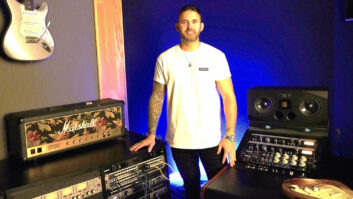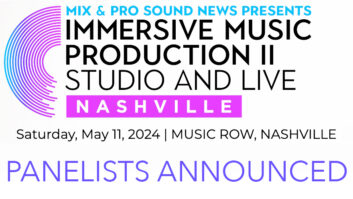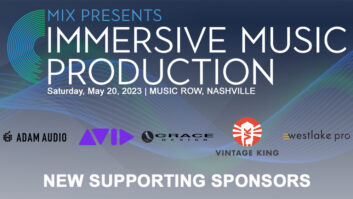LOS ANGELES, CA—The era of putting a microphone up, passing the signal through a mixing console and into a tape recorder has largely gone by the wayside. In this modern era, a record might start in software or as a beat or on an acoustic instrument, and from there, well, it can go in so many directions.
This is not your father’s—or mother’s—record production workflow, as the All-Star Album Production panel at the 141th AES Convention elucidated. The conversation, between recording and mix engineer Marcella Araica; multi-hyphenate Laura Escudé of Alluxe/Electronic Creatives; Coast Mastering’s Piper Payne; and recording engineer Laura Sisk, explored the recording process from every angle, with an emphasis on the gear and the process.
“We have trained over 1,200 women and girls in the recording arts in the only professional recording studio in the world built and run entirely by women,” said moderator Terri Winston, executive director of Women’s Audio Mission in San Francisco, before turning to the panel. “What are everybody’s favorite tools and gear and things that make your workflow more efficient?” she asked.
Araica, who opened her own multiroom facility, Dream Asylum, two years ago, favors the SSL 9000J console. “That is first and foremost the piece of equipment that I need,” said Araica, who has one each in her A and B rooms.
As for outboard, the Tube-Tech CL 1B compressor is “a must for vocals,” she continued, also listing the Neve 33609 stereo compressor. In software, Waves and UA plug-ins got a shout-out, especially the HEQ and Manny Marroquin bundle and the 660 and LA3A emulations.
“Long live analog,” said Payne. “Everything I have is outboard analog, real-time,” including a Maselec MTC-1 transfer console. That said, she does have plug-ins such as iZotope RX and Renovator, and uses the Sequoia DAW. Her converters are iZ Radar Ultra Nyquist: “Awesome.” New to her room are a Manley SLAM (“Stereo Limiter and Micpre”) and two SPL Iron mastering compressor units, she reported.
“Speakers are really, really important,” Payne stressed. “Spend the money.” Her room houses Focal Scala Utopias, “which have a really resolute tweeter.” She counters the brightness with very fast tube amplifiers, VTL MB-450 mono block models.
Sisk’s optimum vocal chain is “a U 47 with a 1073 and a CL 1B,” she said. “I usually like to switch out the compressor or the mic, even for background vocals. If you start layering stuff, especially if it’s well in tune, it can almost sound phasey” otherwise, she said. Sisk also likes the black face 1176.
In software, Melodyne and Autotune are essentials for her vocal productions, sometimes in sequence with each other. “I really like the way that Melodyne can stretch the timing of vocals,” she said. “It can be really invisible.”
A favorite new acquisition is the Walrus Audio’s Contraband pedal. “It’s a beautiful distortion that doesn’t have a lot of high end,” making it ideal for synths and guitars. The pedal’s extreme limiter offers “almost a tremolo effect,” Sisk reported.
Vocal specialist Escudé also employs the Melodyne/Autotune combo. “I can’t name the names of very famous pop artists that tour with Autotune rigs but I’ve set up quite a few of them, at varying levels of the way that it reacts,” she revealed. “It’s a comfort thing; they get used to it in the studio.” She commented, “Ableton Live time stretching is really good, too.”
“Another really powerful plug-in is [Synchro Arts’] Revoice,” said Sisk. “That’s for when you want [vocals] perfectly aligned and perfectly in tune with each other. It’s automatic, but you can select areas where you don’t want it to touch at all. That’s an interesting way to interact with it.”
In response to an audience question asking how they each got established, Araica responded, “Hard work. There was no time clock for me. If it was a 24-hour day or three days straight, that’s what I did. I missed a lot of holidays, birthdays, special events with my family. They were sacrifices I knew I had to make. Little by little, I started taking on new clients” in the U.S. then around the world.
“You have to take the opportunities when they’re given to you,” said Payne. “If you are meeting people and networking and being true to what you want to do in your life, you will get some opportunities. Then be prepared to work your butt off.”
She advised, “Get a mentor. Find somebody that cares about you and wants to help you succeed. Your network will be expanded exponentially. But you have to have some guidance.” In any project, “If you don’t know the audio benchmark is that you’re shooting for, then you’re spinning your wheels. A mentor will help guide you.”
She added, “There are some engineers and producers that make the artist sound like that engineer or producer, and there are some engineers and producers that make the artist sound more like themselves.”
“As a recording engineer, one of the biggest things that I try to do is to be invisible,” said Sisk. “I’m trying not to influence anything too much. I’m trying to understand what the artist wants and what they are hearing in their head and trying to make that happen.”
AES
aes.org







